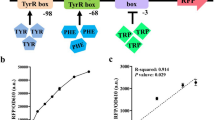Abstract
The global regulatory system of Escherichia coli, carbon storage regulator (Csr), was engineered to increase the intracellular concentration of phosphoenolpyruvate. We examined the effects of csrA and csrD mutations and csrB overexpression on phenylalanine production in E. coli NST37 (NST). Overexpression of csrB led to significantly greater phenylalanine production than csrA and csrD mutations (2.33 vs 1.67 and 1.61 g l−1, respectively; P < 0.01). Furthermore, the overexpression of csrB was confirmed by the observed increase in csrB transcription level. We also determined the effect of overexpressing transketolase A (TktA) or glucose-6-phosphate dehydrogenase (Zwf) in NST and the csrA mutant of NST (NSTCSRA) on phenylalanine production. The NSTCSRA strain overexpressing TktA (NSTCSRA [pTktA]) produced significantly more phenylalanine than that of Zwf (2.39 vs 1.61 g l−1; P > 0.01). Furthermore, we examined the effect of overexpressing TktA, 3-deoxy-d-arabino-heptulosonate-7-phosphate synthase (AroFFR), and chorismate mutase/prephenate dehydratase (PheAFR) together in NSTCSRA (NSTCSRA [pTkaFpA]). It is interesting to note that NSTCSRA [pTkaFpA] produced significantly less phenylalanine than both NSTCSRA [pTktA] and NST overexpressing csrB (NST [pCsrB]) (1.84 vs 2.39 and 2.33 g l−1, respectively; P < 0.01). Thus, csrB overexpression or csrA mutation in combination with tktA overexpression was more effective than previous approaches that targeted the glycolytic or aromatic pathway enzymes for enhancing phenylalanine production.



Similar content being viewed by others
References
Altier C, Suyemoto M, Lawhon SD (2000) Regulation of Salmonella enterica Serovar typhimurium invasion genes by csrA. Infect Immun 68:6790–6797
Backman KC, Balakrishnan R (1988) Enzyme deregulation. US Patent No. 4,753,883
Berry A (1996) Improving production of aromatic compounds in Escherichia coli by metabolic engineering. Trends Biotechnol 14:250–256
Bongaerts J, Krämer M, Müller U, Raevev L, Wubbolts M (2001) Metabolic engineering for microbial production of aromatic amino acids and derived compounds. Metab Eng 3:289–300
Flores S, de Ande-Herrera R, Gosset G, Bolívar FG (2004) Growth-rate recovery of Escherichia coli cultures carrying a multicopy plasmid, by engineering of the pentose-phosphate pathway. Biotechnol Bioeng 87:485–494
Fotheringham I, Ton J, Higgins C (1994) Materials and methods for hypersecretion of amino acids. US Patent No. 5,354,672
Gudapaty S, Suzuki K, Wang X, Babitzke P, Romeo T (2001) Regulatory interactions of Csr components: the RNA binding protein CsrA activates csrB transcription in Escherichia coli. J Bacteriol 183:6017–6027
Hudson GS, Davidson BE (1984) Nucleotide sequence and transcription of the phenylalanine and tyrosine operons of Escherichia coli K12. J Mol Biol 180:1023–1051
Liu MY, Romeo T (1997) The global regulator CsrA of Escherichia coli is a specific mRNA-binding protein. J Bacteriol 179:4639–4642
Liu MY, Gui G, Wei B, Preston JF, Oakford L, Yuksel U, Giedroc DP, Romeo T (1997) The RNA molecule CsrB binds to the global regulatory protein CsrA and antagonizes its activity in Escherichia coli. J Biol Chem 272:17502–17510
Lu JL, Liao JC (1997) Metabolic engineering and control analysis for production of aromatics: Role of transketolase. Biotechnol Bioeng 53:132–138
McCaman MW, Robin E (1962) Fluorimetric method for the determination of phenylalanine in serum. J Lab Clin Med 59:885–890
Patnaik R, Liao JC (1994) Engineering of Escherichia coli central metabolism for aromatic metabolite production with near theoretical yield. Appl Environ Microbiol 60:3903–3908
Patnaik R, Spitzer RG, Liao JC (1995) Pathway engineering for production of aromatics in Escherichia coli: confirmation of stoichiomeric analysis by independent modulation of AroG, TktA, and Pps activities. Biotechnol Bioeng 46:361–370
Romeo T, Tatarko M (2000) A global regulator used to enhance the synthesis of aromatic substances. PCT Patent Publication No. WO 2000/0073484
Romeo T, Snoep JL (2005) In: Böck A (ed) Glycolysis and flux control. EcoSal—Escherichia coli and Salmonella: cellular and molecular biology, chapter 3.5.1. ASM, Washington, DC
Romeo T, Gong M, Liu MY, Brun-Zinkernagel AM (1993) Identification and molecular characterization of csrA, a pleiotropic gene from Escherichia coli that affects glycogen biosynthesis, gluconeogenesis, cell size, and surface properties. J Bacteriol 175:4744–4755
Sabnis NA, Yang H, Romeo T (1995) Pleiotropic regulation of central carbohydrate metabolism in Escherichia coli via the gene csrA. J Biol Chem 270:29096–29104
Sambrook J, Russell DW (2001) Molecular cloning, 3rd edn. Cold Spring Harbor Laboratory Press, New York
Sambrook J, Fritsch EF, Maniatis T (1989) Molecular cloning: a laboratory manual. Cold Spring Harbor Laboratory Press, New York
Suzuki K, Babitzke P, Kushner SR, Romeo T (2006) Identification of a novel regulatory protein (CsrD) that targets the global regulatory RNAs CsrB and CsrC for degradation by RNase E. Genes Dev 20:2605–2617
Tatarko M, Romeo T (2001) Disruption of global regulatory gene to enhance central carbon flux into phenylalanine biosynthesis in Escherichia coli. Curr Microbiol 43:26–32
Tribe DE (1987) Novel microorganism and method. US Patent No. 4,681,852
Weilbacher T, Suzuki K, Dubey AK, Wang X, Gudapaty S, Morozov I, Baker CS, Georgellis D, Babitzke P, Romeo T (2003) A novel sRNA component of the carbon storage regulatory system of Escherichia coli. Mol Microbiol 48:657–670
Weikert C, Sauer U, Baily JE (1998) Increased phenylalanine production by growing and nongrowing Escherichia coli strain CWML2. Biotechnol Prog 14:420–424
Author information
Authors and Affiliations
Corresponding author
Rights and permissions
About this article
Cite this article
Yakandawala, N., Romeo, T., Friesen, A.D. et al. Metabolic engineering of Escherichia coli to enhance phenylalanine production. Appl Microbiol Biotechnol 78, 283–291 (2008). https://doi.org/10.1007/s00253-007-1307-z
Received:
Revised:
Accepted:
Published:
Issue Date:
DOI: https://doi.org/10.1007/s00253-007-1307-z




